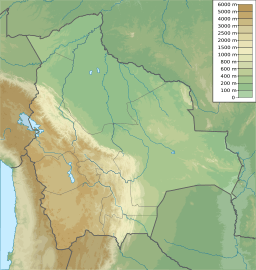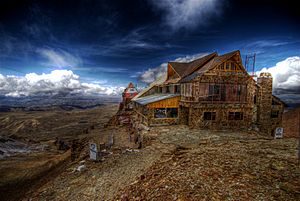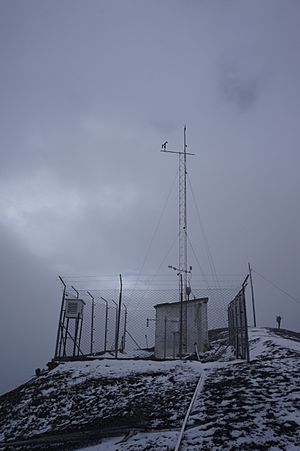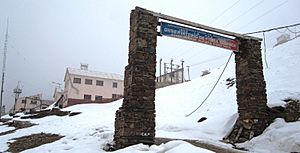Chacaltaya facts for kids
Quick facts for kids Chacaltaya |
|
|---|---|

Chacaltaya peak, October 2012
|
|
| Highest point | |
| Elevation | 5,421 m (17,785 ft) |
| Geography | |
| Location | La Paz Department, Bolivia |
| Parent range | Cordillera Real, Andes |
| Geology | |
| Mountain type | Fold mountain |
| Climbing | |
| Easiest route | Walk up |
Chacaltaya is a mountain in Bolivia. Its name comes from the Mollo language, meaning "bridge of winds" or "winds meeting point". In Aymara, it means "cold road".
Chacaltaya is part of the Cordillera Real mountain range. This range is a section of the Andes mountains in Bolivia. The mountain stands very tall, reaching 5,421 meters (17,785 ft) above sea level.
For a long time, Chacaltaya had a glacier on its peak. This glacier was incredibly old, about 18,000 years old! In 1940, it covered an area of 0.22 km2 (0.085 sq mi). But over the years, it started to shrink. By 2007, it was only 0.01 km2 (0.0039 sq mi). Sadly, by 2009, the glacier had completely disappeared.
Scientists say that half of the glacier melted before 1980. The rest melted quickly after 1980. This was due to less snow falling and warmer weather from something called El Niño. The glacier was located about 30 kilometers (19 mi) from the city of La Paz.
Contents
Bolivia's Highest Ski Area
The glacier on Chacaltaya used to be Bolivia's only ski resort. It was known as the highest ski area in the world with a ski lift. It was also the most northern ski area in South America.
The ski lift was a special rope tow. It was the very first one built in South America, back in 1939. It even used an old car engine to power it! This rope tow was inside the original wooden lodge at the site. Today, it no longer works.
A narrow road, also built in the 1930s, leads to the base of the ski slope. The slope itself was about 200-meter (660 ft) long. Because of the very cold weather, the ski lift usually only ran on weekends. This was from November to March.
Since 2009, there isn't enough snow for full skiing. Now, skiing is limited to a small 600-foot (180 m) section. This part sometimes gets enough snow during the winter.
A Mountain for Climbers
Chacaltaya is also popular with people who enjoy climbing mountains. The road goes very high up the mountain. It stops only 200 metres (660 ft) from the very top. This makes it easier for amateur mountaineers to reach the summit.
The ski resort also had a restaurant. The Guinness World Records once called it the highest restaurant in the world!
The Vanishing Glacier
Scientists at the Mount Chacaltaya Laboratory began studying the glacier in the 1990s. At that time, they thought the glacier would last until about 2015. However, it melted much faster than anyone expected. By 2009, only a few small patches of ice and snow were left. These were near the very top of the mountain.
Many people in Bolivia rely on water from melting glaciers. This is especially true for those living on the Altiplano. The big cities of La Paz and El Alto also depend on this water. They need it for part of their water supply during the dry season.
The World Bank has warned about glaciers in the Andes mountains. They expect many of these glaciers to disappear within 20 years. This could affect the water supply for nearly 80 million people. It also threatens the future of hydropower, which is electricity made from water. Countries like Bolivia, Ecuador, and Peru get about half of their electricity from hydropower.
The Chacaltaya Observatory
High up on Mount Chacaltaya, at 5,240 meters (17,190 ft), is the Mount Chacaltaya Laboratory. It started as a weather station in 1942. This lab is very important for studying gamma rays. In the 1940s, it was where scientists first observed tiny particles called pions.
The Chacaltaya (Astrophysical) Observatory is part of the Universidad Mayor de San Andrés. It also works with other universities around the world. The observatory has a group that studies cosmic rays.
Since 2011, it has also been home to the Chacaltaya Global Atmosphere Watch (GAW) station. This GAW station is one of the few places in the Southern Hemisphere that monitors important climate information. This includes weather details, tiny particles in the air called aerosols, and greenhouse gases.
See also
 In Spanish: Chacaltaya para niños
In Spanish: Chacaltaya para niños
- List of highest astronomical observatories
- Retreat of glaciers since 1850






